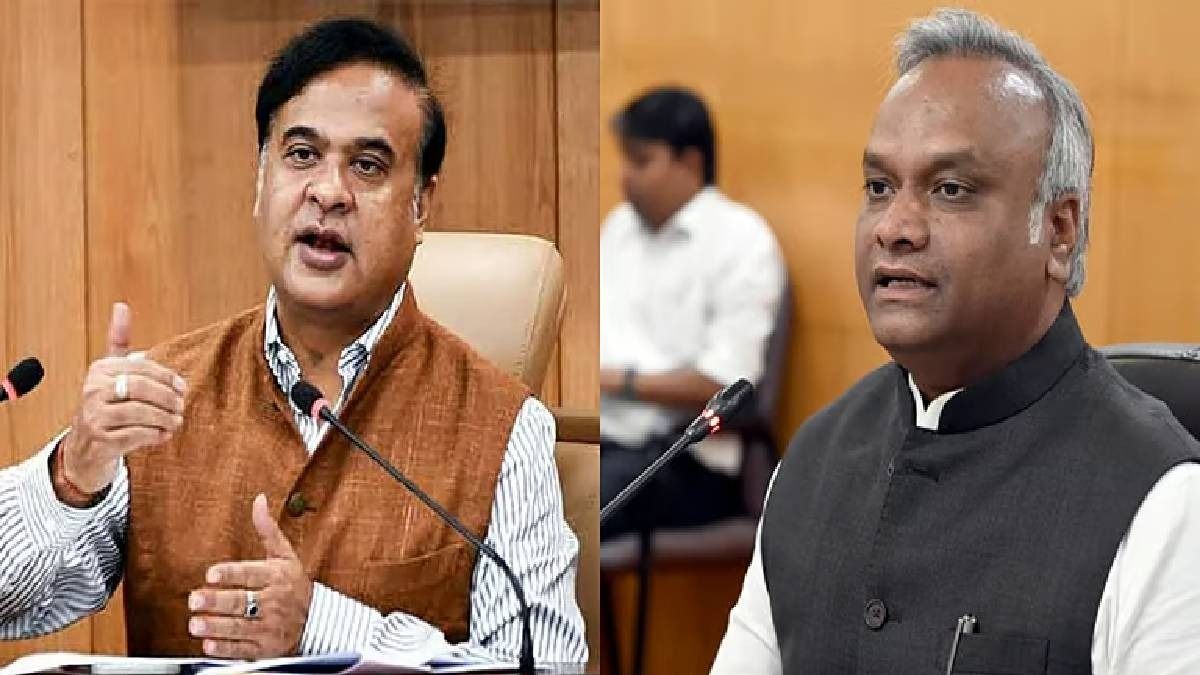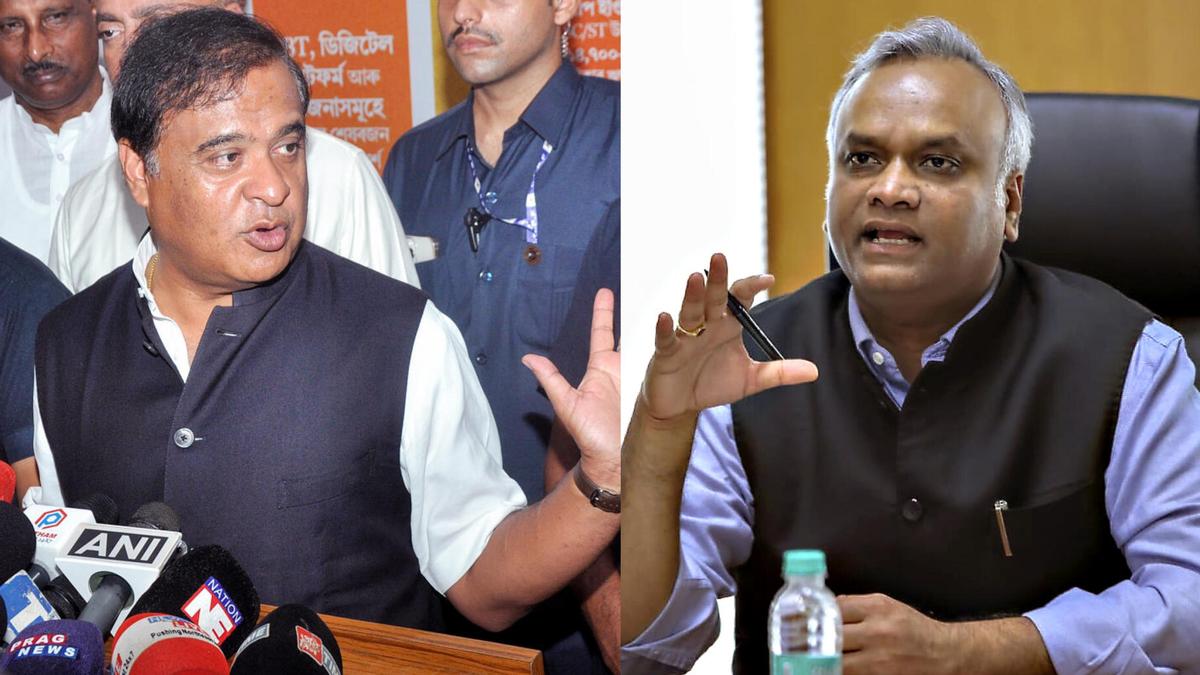A digital storm has gripped India’s political state landscape as the social media sparring between Karnataka’s IT-BT Minister Priyank Kharge and Assam Chief Minister Himanta Biswa Sarma continues to escalate. What began as a war of words over governance and regional priorities has now evolved into a broader political confrontation played out publicly across social platforms. With each tweet and counter-response, the feud has not only drawn nationwide attention but also highlighted how social media has become the new battleground for India’s federal politics.
Origin of the Dispute
The verbal crossfire began when Priyank Kharge, known for his outspoken presence online, criticised certain northeastern governance models while defending Karnataka’s progressive policies in sectors like technology, welfare, and education. Sarma, never one to let a remark pass unanswered, swiftly retaliated by questioning Karnataka’s administrative record and accusing Kharge of indulging in political theatrics.
What could have been a brief exchange soon spiralled into a heated online rivalry. Both leaders began posting pointed remarks that touched on broader themes of development, ideological orientation, and political responsibility. Their exchanges, punctuated by sharp wit and rhetorical flair, have since kept both states’ followers hooked, drawing millions of impressions and triggering widespread commentary across India’s digital space.
Political Context and Underlying Tensions
While the feud appears to be a war of words, analysts believe it reflects deeper ideological and regional undercurrents. Kharge, representing Karnataka’s Congress government, has often positioned himself as a vocal critic of the BJP’s national leadership. Sarma, on the other hand, is a senior BJP leader and one of the most prominent chief ministers from the northeast.

The confrontation, therefore, embodies more than personal rivalry—it mirrors the ongoing Congress-BJP ideological clash that defines India’s current political climate. Experts note that both leaders are using social media not merely as a platform for rebuttal but as a stage for mobilising support, reinforcing regional pride, and showcasing their party’s policy stances.
Tone and Style of the Exchanges
The exchanges between Kharge and Sarma have been marked by a mix of humour, sarcasm, and assertive language. Kharge’s responses typically emphasise Karnataka’s governance model—its welfare schemes, digital infrastructure, and technological advancements—while Sarma counters with remarks about efficiency, fiscal discipline, and ideological consistency.
In recent days, the tone has grown sharper, with both leaders directly naming each other in posts that garner significant public traction. Social media analysts note that the exchanges are carefully curated to resonate with each leader’s core audience—Kharge’s rhetoric appeals to urban, tech-oriented youth, while Sarma’s tone caters to nationalists and party loyalists who value assertive communication.
Digital Politics: The Rise of Social Media Rivalries
The ongoing feud illustrates how social media has reshaped India’s political communication. Once limited to speeches and press releases, debates between politicians now unfold in real time before millions of users. This immediacy amplifies political reach but also heightens the risk of polarisation.
Political strategists argue that online sparring is no longer accidental—it’s a calculated part of public engagement. By taking debates to digital platforms, leaders like Kharge and Sarma ensure constant visibility and direct interaction with voters. Their posts often blend personal conviction with party narratives, blurring the lines between individual opinion and institutional stance.
Yet, critics warn that such exchanges, while entertaining, risk overshadowing substantive governance debates. As the feud between the two leaders intensifies, questions arise about whether these digital duels enhance democratic dialogue or merely feed performative politics.
Public and Political Reactions
The social media feud has sparked strong reactions across the political spectrum. Supporters of both leaders have rallied online, turning comment sections into arenas of ideological confrontation. Congress loyalists have praised Kharge for defending Karnataka’s progressive image, while BJP supporters have applauded Sarma for standing firm and challenging what they perceive as political provocation.
Neutral observers, however, see the spat as reflective of a growing tendency among politicians to prioritise online optics over policy outcomes. Some civil society members argue that such exchanges distract from real issues like job creation, infrastructure development, and inter-state cooperation. Still, others appreciate the transparency that such public disagreements bring, viewing them as a sign of democratic engagement in the digital age.
Media Coverage and Narrative Building
Traditional media outlets have been quick to amplify the story, dedicating columns, talk shows, and editorials to dissect the ongoing feud. Each side’s statements are scrutinised for political intent, language choice, and broader implications. The exchanges have also become fodder for memes and debates across television and radio, blending political analysis with public entertainment.
Political commentators note that such feuds contribute to the “spectacle effect” in modern politics, where attention often outweighs nuance. By drawing viewers and readers, these spats keep both politicians relevant in the fast-moving news cycle. Media experts argue that this dynamic often rewards aggression and wit over collaboration and policy depth.
Rival Strategies and Political Symbolism
For Priyank Kharge, the ongoing exchange serves as a platform to project Karnataka’s image as a progressive, tech-driven state that champions secularism and welfare. His posts often highlight data-driven governance and citizen welfare initiatives as counterpoints to ideological criticism. The strategy resonates with the Congress narrative of inclusive development.
Himanta Biswa Sarma, conversely, has positioned himself as a defender of decisive governance and cultural pride. His communication strategy underscores discipline, nationalism, and administrative performance. Through his responses, Sarma reinforces the BJP’s national message of strength and continuity, ensuring his words echo beyond Assam’s borders.
Both leaders, despite their differences, share a keen awareness of digital optics. Every tweet is crafted with precision—each statement serves dual purposes: reinforcing state pride while fuelling the broader political storyline between the two dominant parties.
The Role of Youth and Online Engagement
Younger citizens have emerged as active participants in the feud, using social media platforms to voice opinions, share memes, and interpret the exchanges through their own creative lenses. For many urban youth, the ongoing sparring between Kharge and Sarma symbolizes a new form of political theatre—dynamic, bold, and unfiltered.
However, educators and social scientists warn that such online intensity may blur the distinction between informed debate and emotional reaction. They urge digital literacy initiatives to help citizens evaluate political content critically, especially when it involves high-profile leaders whose statements can shape public sentiment rapidly.
National Implications and Inter-State Dynamics
Beyond entertainment, the ongoing exchange has subtle implications for inter-state relations and federal politics. Karnataka and Assam, though geographically distant, represent contrasting models of governance—one driven by tech innovation and welfare schemes, the other emphasising administrative control and cultural consolidation.
As both leaders defend their respective states online, they indirectly highlight the diverse governance philosophies within India’s federal structure. The feud, in essence, has evolved into a symbolic contest between two political cultures—one that prides itself on progressive policies and another on assertive nationalism. Observers believe such online rivalries could increasingly shape national discourse in the coming years.
Expert Opinions and Sociopolitical Analysis
Political sociologists interpret the feud as a product of India’s digital transformation. According to analyst Ramesh Chandra, “Social media has democratised political dialogue, but it has also incentivised confrontation. Leaders now compete not just for votes but for virality.” Others note that the Kharge-Sarma exchanges exemplify how online communication can blur institutional boundaries, where personal remarks become political positions.
Communication experts stress that the intensity of online rivalry also signals a changing electorate—one that values immediacy and emotional connection. In this context, the Kharge-Sarma feud is less about disagreement and more about visibility, engagement, and identity projection.
Timeline of the Feud
The first exchange reportedly occurred in late September 2025, when Kharge made a statement highlighting Karnataka’s leadership in digital innovation. Sarma responded days later with a tweet questioning the efficiency of the state’s public services. The back-and-forth intensified through October, drawing interventions from party spokespersons and media commentators.
Both leaders have since posted multiple responses, occasionally referencing national issues like federal resource sharing, employment, and ideological commitment. Despite periodic calls for restraint from supporters, neither side has indicated any intention to de-escalate the online rivalry.

Broader Lessons and Public Reflection
While the feud continues to dominate headlines, it also serves as a case study on how technology has changed political behaviour. The immediacy of online exchanges can both empower leaders and expose them to public scrutiny. For citizens, it offers direct access to political discourse, but it also requires discernment to separate meaningful debate from performative aggression.
Political psychologists note that such feuds can influence emotional voting behaviour by shaping public perceptions of strength, intelligence, and authenticity. They argue that while spirited debate is healthy for democracy, its digital form must evolve toward respect and responsibility.
Conclusion
The ongoing social media sparring between Karnataka’s Priyank Kharge and Assam’s Himanta Biswa Sarma has transcended regional boundaries to become a national conversation about political communication, leadership, and digital democracy. It highlights both the power and the peril of instant interaction in an era where every statement travels across the country in seconds.
What began as a disagreement between two leaders has evolved into a reflection of India’s changing political landscape—where dialogue, dissent, and performance coexist on the same digital stage. Whether this feud leads to deeper political insight or simply more spectacle remains uncertain. But one thing is clear: in modern India, governance is no longer confined to offices and assemblies—it unfolds, tweet by tweet, in the public eye.
Follow: Karnataka Government
Also read: Home | Channel 6 Network – Latest News, Breaking Updates: Politics, Business, Tech & More

